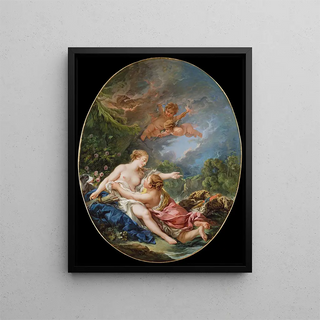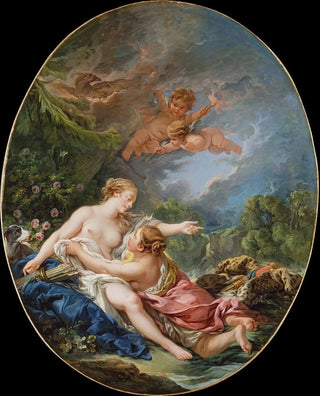Art print | Jupiter and Callisto - François Boucher Source: Reproduction | Jupiter et Callisto - François Boucher


View from behind

Frame (optional)
The artwork "Jupiter and Callisto" by François Boucher is a true ode to beauty and sensuality, immersed in a rich and evocative mythological universe. Painted in the 18th century, this iconic canvas embodies the aesthetic values of rococo, an artistic movement that celebrates elegance, lightness, and a certain carefree spirit. Through this piece, Boucher transports us to a world where gods and mortals intertwine in tales of love and passion, while revealing the virtuosity of his brushwork. The artist, by choosing to depict the tragic moment of Callisto's betrayal by Jupiter, succeeds in capturing the very essence of human emotion, inviting us to contemplate the subtleties of romantic relationships and the consequences of beauty.
Style and uniqueness of the work
Boucher's style is distinguished by its shimmering palette and dynamic compositions. In "Jupiter and Callisto", pastel colors and delicate forms create a dreamlike atmosphere, while the figures are rendered with unmatched grace and sensuality. The artist skillfully plays with light and shadow, emphasizing the curves of the bodies and the drapery of the clothing, which gives the entire piece a sense of movement and life. The meticulous details, such as facial expressions and gestures, demonstrate attentive observation of human nature. While rooted in mythology, this painting resonates deeply with universal emotions, making the work timeless and accessible to all.
The artist and his influence
François Boucher, one of the masters of rococo, marked his era with his flamboyant style and his ability to depict beauty in all its forms. Trained at the Royal Academy of Painting and Sculpture, he established himself as an essential artist of the 18th century, influencing many contemporaries and successors. His work, often commissioned by the nobility, reflects the tastes of his time, blending sensuality and sophistication. By celebrating mythology and nature, Boucher contributed to shaping an aesthetic that endures to this day. His influence

Matte finish

View from behind

Frame (optional)
The artwork "Jupiter and Callisto" by François Boucher is a true ode to beauty and sensuality, immersed in a rich and evocative mythological universe. Painted in the 18th century, this iconic canvas embodies the aesthetic values of rococo, an artistic movement that celebrates elegance, lightness, and a certain carefree spirit. Through this piece, Boucher transports us to a world where gods and mortals intertwine in tales of love and passion, while revealing the virtuosity of his brushwork. The artist, by choosing to depict the tragic moment of Callisto's betrayal by Jupiter, succeeds in capturing the very essence of human emotion, inviting us to contemplate the subtleties of romantic relationships and the consequences of beauty.
Style and uniqueness of the work
Boucher's style is distinguished by its shimmering palette and dynamic compositions. In "Jupiter and Callisto", pastel colors and delicate forms create a dreamlike atmosphere, while the figures are rendered with unmatched grace and sensuality. The artist skillfully plays with light and shadow, emphasizing the curves of the bodies and the drapery of the clothing, which gives the entire piece a sense of movement and life. The meticulous details, such as facial expressions and gestures, demonstrate attentive observation of human nature. While rooted in mythology, this painting resonates deeply with universal emotions, making the work timeless and accessible to all.
The artist and his influence
François Boucher, one of the masters of rococo, marked his era with his flamboyant style and his ability to depict beauty in all its forms. Trained at the Royal Academy of Painting and Sculpture, he established himself as an essential artist of the 18th century, influencing many contemporaries and successors. His work, often commissioned by the nobility, reflects the tastes of his time, blending sensuality and sophistication. By celebrating mythology and nature, Boucher contributed to shaping an aesthetic that endures to this day. His influence






